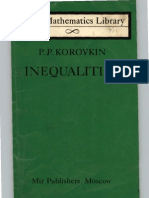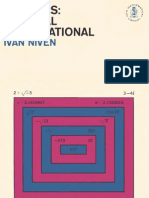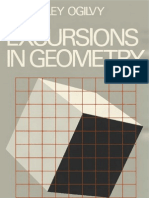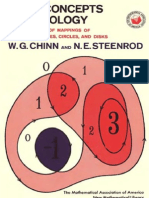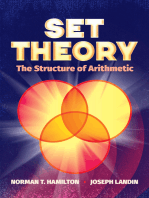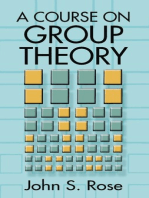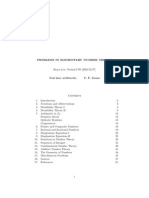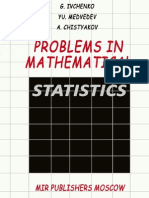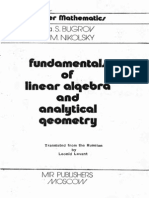MIR - LML - Shilov G. E. - Plotting Graphs
MIR - LML - Shilov G. E. - Plotting Graphs
Uploaded by
avast2008Copyright:
Available Formats
MIR - LML - Shilov G. E. - Plotting Graphs
MIR - LML - Shilov G. E. - Plotting Graphs
Uploaded by
avast2008Copyright
Available Formats
Share this document
Did you find this document useful?
Is this content inappropriate?
Copyright:
Available Formats
MIR - LML - Shilov G. E. - Plotting Graphs
MIR - LML - Shilov G. E. - Plotting Graphs
Uploaded by
avast2008Copyright:
Available Formats
nOnYlljfpHblE llEKUJ,1H no MATEMATHKE
r E. lIIMJIOB
KAK CTPOI1Th
rPA<Ill1KI1
H3JlaTeJIbCTBO Hayxa Mocxaa
LITTLE MATHEMATICS LIBRARY
G.E.Shilov
PLOTTING
GRAPHS
Translated from the Russian
by
S. Sosinsky
MIR PUBLISHERS
MOSCOW
First published 1978
Ha aH2AUUCKOM flJblKe
. English translation, Mir Publishers, 1978
The graph of the sine, wave after wave,
Flows along the axis of abscissas...
(FROM STUDENT LORE)
It would be hard to find a field of science or social life where
graphs are not used. We have all often seen graphs, for example,
of industrial growth or increase in labour productivity. Natural
phenomena like daily or annual fluctuations of temperature or
atmospheric pressure are also easier to describe by means of graphs.
The plotting of graphs of that kind presents no difficulty, provided
the appropriate tables have been compiled. But we shall be
dealing here with graphs of a different kind, with graphs that
must be plotted from given mathematical formulas. A need for
such graphs often arises in various fields of knowledge. Thus, in
analysing the theoretical course of some physical process, a
scientist obtains a formula yielding some magnitude with which
he is concerned, for example, the amount of product obtained
relative to time. The graph plotted from this formula will provide
a clear picture of the future process. Looking at it, the scientist
may possibly introduce substantial changes into the scheme of
his experiment in order to obtain better results.
In this booklet we shall consider some simple methods of
plotting graphs from given formulas.
Let us draw two mutually perpendicular lines on a plane, one
horizontal and the other vertical, denoting their intersection by O.
II
We shall call the horizontal line the axis of abscissas and the
vertical the axis of ordinates. Each axis will be divided by the
point 0 into two semi-axes, positive and negative, the right half
of the axis of abscissas and the upper half of the axis of
ordinates being taken as positive, while the left half of the axis
of abscissas and the lower half of the axis of ordinates being
taken as negative. Let us mark the positive semi-axes by arrows.
The position of any point M on the plane can now be determined
by a pair of numbers. To find them we drop perpendiculars
from M to each of the axes; these perpendiculars intercept
segments OA and OB (Fig. 1) on the axes. The length of segment OA,
taken with a plus sign + when A is on the positive semi-axis and
with a minus sign - when it is on the negative semi-axis, we call
5
the abscissa of point M and denote by x. Similarly, the length
of segment OB (with the same sign rule) we call the ordinate
of point M and denote by y. The two numbers x and yare
called the coordinates of point M. Every point on the plane has
certain coordinates. The points on the axis of abscissas have zero
ordinates and the points on the axis of ordinates have zero abscissas.
The origin of the coordinates 0 (the point of intersection of the
A
x
y
o
B --------I
M
I
I
I
I
Fig. 1
axes) has both coordinates equal to zero. Conversely, when we are
given any two numbers x and y (negative or positive), we can
always plot a point M with abscissa x and ordinate y; to do that
we measure off a segment OA = x on the axis of abscissas and
draw a perpendicular AM = y at point A (bearing in mind the
sign); M will be the point we want.
Suppose we are given a formula for which we are to plot
the graph. The formula must indicate what operations must be
carried out on the independent variable (denoted by x) in order
to obtain the value we need (denoted by y). For example, the
formula
y = 1 + x
2
indicates that the value of y can be obtained by squaring the
independent variable x, adding it to unity and dividing unity by
the result. If x assumes some numerical value .xo, then in
accordance with our formula y will assume some numerical value Yo.
The numbers Xo and Yo will determine a certain point M0
in the plane of our picture. Instead of Xo we can take "some
other number Xl and use the formula to calculate a new value YI;
the pair of numbers (Xl' YI) will define a new point M 1 on the
plane. The locus of all points whose ordinates are related to their
abscissas by the given formula is called the graph of this formula.
The set of points on a graph, generally speaking, is infinite,
6
and we cannot hope in fact to plot them all without exception
according to the given rule. But we can manage without it.
In most cases it is enough to know a small number of points
in order to be able to judge the general form of the graph.
.,
o o
o
o
o
Fig. 2
The point-by-point plotting of a graph consists simply in
plotting a certain number of points of the graph and then joining
them (as far as possible) by a smooth curve.
As an example, let us consider the graph of the function
y = 1 + x
2
Let us compile the following table:
(1)
x 0 1 2 3 -1 -2 -3
y
In the first line we have written down values for x = 0, 1, 2,
3, -1, - 2, - 3. We usually take integral numbers for x because
they are easier to operate with. In the second line we have
y
o
- - - - - - 1 ~ - ~ I _ _ _ - _ _ _ _ _ f - - ~ - - _ + - - _ _ + . - - _ _ + ~ X
Fig. 3
written the corresponding values for y obtained from formula (1).
Let us plot the corresponding points on the plane (Fig. 2).
Joining them by a smooth line, we obtain the graph (Fig. 3).
7
(2)
y = (3x2 - 1)2
The point-by-point plotting, as we see, is extremely simple
and requires no 'theory' But, perhaps just because of that, we can
make bad mistakes by- blindly following it.
Let us plot the curve given by the equation
1
using this rule.
y
o o
Fig. 4
The table of values for x and y corresponding to this equation
is as follows:
x o 2 3 -1 -2 -3
y
1/
6 76
The corresponding points on the plane are shown in Fig. 4.
The outline looks very like the previous one; joining the points
by a smooth line we obtain a graph (Fig. 5). Now it seems
o
Fig. 5
we can put down our pens and take a deep breath; we have
mastered the art of plotting graphs! But just in case, as a check,
let us calculate y for some intermediate value of x, say x = 0.5.
We get a surprising result: for x = 0.5, y = 16. This sharply disagrees
with our picture. And there is no guarantee that in calculating
8
y for other intermediate values of x - and there is an in'inite
number of such values - we would not obtain even more striking
incongruities. Apparently the point-by-point plotting of a graph
itself is not well-founded.
*
* *
Now we shall consider another method of plotting graphs, more
reliable since it protects us from those unexpected things we have
just come across. This method - let us call it 'plotting by opera-
tions' - consists in carrying out directly on the graph all the
operations which are written down in the given formula: addition,
subtraction, multiplication, division, etc.
Let us consider some of the simplest examples. We plot the
graph corresponding to the equation
y = x (3)
This equation shows that all the points of the sought line on
- - - - - - # - - - - - ~ X
Fig. 6
- - ~ - + - - - - # - - - + - - - t - - ~ X
y= kx
with some coefficient k is obtained from the previous one by
multiplying each ordinate by the same number k. Suppose, for
example, k == 2; each ordinate of the previous graph must be
doubled. and .. as a result, we obtain a straight line more steeply
Fig. 7
the graph have equal abscissas and ordinates. The locus of points
having an ordinate equal to an abscissa is the bisector of the
angle formed by the positive semi-axes and the angle formed
by the negative semi-axes (Fig. 6). The graph corresponding to the
equation
2-19
9
rising upwards (Fig. 7). Each step to the right along the x..axis
corresponds to two steps along the y-axis. Incidentally, it is very
convenient to plot such graphs on squared or graph paper. In the
general case we will also get a straight line in the equation
y = kx. If k > 0, the line, with each step to the right, will move
up k steps along the y-axis. If k < 0, the line will slope down
instead.
- - - - # - ~ - - - ~ x
Fig. 8
Now let us consider a somewhat more complicated formula
y = kx + b (4)
To plot a corresponding graph, we must add one and the
same number b to each ordinate of the already known line y = kx.
As a result, the line y = kx will move up, as a whole, by b
units if b > 0; if b < 0, the original line will, of course,move
down instead. We will thus obtain a straight line parallel to the
initial one, but no longer passing through the origin of coordinates
and intercepting the segment b on the axis of ordinates (Fig. 8).
Therefore, the graph of any polynomial of degree one in x
is a straight line which can be plotted according to the above
rules.
Now let us consider the graph of polynomials of degree two.
Let us consider the formula
y = x
2
(5)
It can be represented In the form
Y =Yi
where
Yt = x
In other words, we will obtain the sought graph by squaring
10
each ordinate of the known line y = x. Let us see what we get in that
way.
Since 0
2
= 0, 1
2
= 1, (- 1)2 = 1, we have obtained three basic
points A, Band C (Fig. 9). When x > 1, Xl > x; therefore, to
the right of point B, the graph will lie above the bisector of
the quadrant angle (Fig. 10). When 0 < x < 1, 0 < x
2
< x; therefore,
between points A and B the graph will lie below the bisector.
y
Co
08
A
x
-1
0
Fig. 9
Moreover, we claim that when we approach point A, the graph
will be contained in any angle bounded from above by the straight
line y = kx (with an arbitrarily small k), and from below by the
x-axis; indeed, the inequality
Xl < kx
is satisfied only if x < k. This fact means that our curve is
tangent to the axis of abscissas at point 0 (Fig. 11). Now let
B
/
/
/
/
A /
X
X
0
0
Fig. 10
Fig. 11
2*
11
y
us move along the x-axis to the left of point O. We know that
the numbers - a and + a give the same square (+ a
2
). Thus
the ordinate of our curve for x = - a will be the same as for
x = +a. Geometrically this means that the graph of the curve
in the left half-plane will be a mirror image of the already
plotted graph in the right half-plane with respect to the y-axis.
We have obtained a curve called a parabola (Fig. 12).
o
- - ~ ~ - - - ~ ~ x
- - - - + - - - - - . : . ~ - - + _ _ - ~ x
Fig. 12 Fig. 13
Now by the same method we can plot a more complicated
curve
(6)
and an even more complicated one
y == ax? + h (7)
The first is obtained by multiplying all the ordinates of parabola
(5), which we will call the standard parabola, by the number a.
For a > 1 we get a similar curve but more steeply rising
upwards (Fig. (3). For 0 < a < 1 the curve will be steeper (Fig. (4),
and for a < 0 its branches will turn upside down (Fig. 15). Curve (7)
is obtained from curve (6) by moving it up by a distance h
if h > 0 (Fig. 16). But if h < 0, we will have to move the curve
down instead (Fig. 17). All these curves are also called parabolas.
Now let us consider a somewhat more complicated example
of plotting a graph by multiplication. Suppose we are to plot
the graph according to the equation
y == x(x - I)(x - 2)(x - 3)
(8)
12
y
Fig. 14
y
Fig. 15
Fig. 16
13
Here we are given the product of four factors. Let us plot
the graph of each of them separately: they are all straight lines,
parallel to the bisector of the quadrant angle and intercepting
the y-axis at points 0, -1, -2, -3, respectively (Fig. 18).
At points 0, 1, 2, 3, on the x-axis, our curve will have a zero
ordinate, since a product is equal to zero if at least one of
the factors is zero. At other points the product will be non-zero
Fig. 17
and will have a sign which can easily be found from the signs
of the factors. Thus, to the right of point 3 all the factors are
positive, therefore, so is their product. Between points 2 and 3 one
factor is negative, therefore, so is the product. Between points 1
and 2 there are two negative factors, so the product is positive,
etc. We obtain the following distribution of signs of the product
(Fig. 19). To the right of point 3 all the factors increase with
Fig. 18
14
x, therefore, the product will also increase and very rapidly. To
the left of point 0 all the factors increase in the negative
direction, so the product (which is positive) will also rapidly increase.
Now it is easy to sketch the general form of the graph
(Fig. 20).
So far we have used the operations of addition and multipli-
cation. Now let us consider division. Let us plot the curve
1
Y = t + x
2
y
+
+ +
x
0
2 3
(9)
Fig. 19
To do that we separately plot the graphs of the numerator and
the denominator. The graph of the numerator
Yt = 1
is a straight line parallel to the x-axis and passing through unity.
The graph of the denominator
Y2 == x
2
+ 1
y
Fig. 20
15
is a standard parabola, moved upwards by unity. Both of these
graphs are shown in Fig. 21.
Now we will carry out the division of each ordinate of the
numerator by the corresponding (i. e. taken for the same x)
ordinate of the denominator. When x == 0, we see that Yl == Y2 == 1,
which yields y == 1. When x i= 0, the numerator is less than the
denominator, so that the quotient is less than unity. Since the
numerator and the denominator are positive everywhere, the
quotient is positive, and, therefore, the graph is contained in the
strip bounded by the x-axis and the line y == 1. When x
infinitely increases, the denominator also grows infinitely, whereas
the numerator remains constant; therefore, the quotient tends to
zero. All this gives the following graph of the quotient (Fig. 22).
We have obtained the same picture as the one plotted previously
by the point-by-point plotting of a graph (p. 7}.
When carrying out division on the graph, particular attention
should be paid to those values for x at which the denominator
becomes zero. If the numerator is non-zero at this point, the
quotient becomes infinite. For example, let us plot the curve
1
y == ~ (10)
Here, the graphs of the numerator and the denominator are already
known (Fig. 23). For x = 1 we have Yl == Y2 == 1, which yields
Y == 1. When x > 1, the numerator is less than the denominator
and the quotient is less than unity as in the previous example.
When x increases infinitely, the quotient tends to zero and we
obtain the part of the graph which corresponds to the values
x > 1 (Fig. 24).
Let us consider now the values for x between and 1. When x
moves from 1 to 0, the denominator tends to zero, while the
numerator remains equal to unity. Therefore, the quotient increases
infinitely and we obtain the branch moving up to infinity
(Fig. 25). When x < 0, the denominator as well as the whole
fraction become negative. The general form of the graph is presented
in Fig. 26. Now we can already start to plot the graph
discussed on page 8:
1
Y == (3x2 _ 1)2 (11)
Let us first plot the graph of the denominator. The curve
Y1 == 3x
2
is a 'triple' standard parabola (Fig. 27). Subtracting unity
we move the graph down by unity (Fig. 28). The curve intersects
the x-axis at two points which will be easily found by setting
16
Numerator
o
Fig. 21
o
Fig. 22
y
Numerator
- - - - - - - # - - - I - - - - - - ~ x
Fig. 23
17
3x
2
- 1 equal to zero:
Xl.2 = M= 0.577...
Now let us square the obtained graph. At points Xl and X2
the ordinates remain equal to zero. All the other ordinates will
be positive, so that the curve will lie above the x-axis. At the
point x = 0 the ordinate will be equal to (- 1)2 = 1 and this
y
Numerator
Fig. 24
y
Fig. 25
will be the greatest ordinate of the part of the graph between
Xl and X2. Outside this part the curve will steeply rise upwards
on both sides (Fig. 29).
Numerator
---+-----Jlr---
o
Numerator
X
..
Fig. 26
1.8
y
y
o
Fig. 27
Fig. 28
y
y
-1
I
I
I
I
I
I
I Numerator
I
Denominator
o
Fig. 29 Fig. 30
19
The graph of the denominator has been plotted. In the same
drawing the dotted line shows the graph of the numerator Y3 = 1.
Now we only have to divide the numerator by the denominator.
Since both of them have the same sign everywhere, the quotient
will be positive, and the whole graph will lie above the x-axis.
When x = 0, the numerator and the denominator are equal, and
their quotient is equal to unity. Let us move along the x-axis
y
~
o
o
c
e
o
e
II
Q
Numerator
Fig. 31
to the right from point O. The numerator remains equal to unity
and the denominator decreases; therefore, the quotient increases
beginning with unity. When we reach the value X2 = 0.577...
the denominator will become equal to zero. This means that the
quotient will become infinite by this moment (Fig. 30). Beyond
the point X2 the denominator will quickly move in the opposite
direction from the zero value to unity and will then infinitely
increase. On the contrary, the quotient will return from infinity
to unity intersecting the straight line y" = 1 at the same point as Y3
and further will indefinitely approach zero (Fig. 31).
The same picture will be obtained to the left of the axis of
ordinates (Fig. 32).
We have marked on this graph the points corresponding to
the integral values for x = 0, 1, 2, 3, -1, -2, - 3. These are
the same points which have been taken in the point-by-point
plotting of a graph on page 8. But the actual form of the graph
20
y
Fig. 32
Fig. 33
Fig. 34
21
radically differs from the one proposed in Fig. 5. We see that
actually instead of smoothly decreasing from the value of 1 (for
x = 0) to the value of 1/4 (for x = 1) and further, the curve
moves upwards to infinity. Here we can see the point with
coordinates x = 1/2, y = 16 which had no place on the previous
incorrect graph but which gets in quite nicely on the new correct one.
*
* *
Summarizing the general rules which should be applied to plot
graphs 'by operations', we can say:
(a) All the operations contained in the given formula must
be carried out with the graphs going from simple ones to more
complicated.
(b) When multiplying graphs pay attention to the points where
factors (at least one of them) become zero; remember the rule of
signs between those points.
(c) When dividing graphs pay attention to the points where
denominator vanishes. If at those points numerator is non-zero,
the branches of the curve will move to infinity - up or down
depending on the signs of the numerator and the denominator.
(d) Pay attention to the behaviour of the curve when x
moves indefinitely to the right (to +(0) or to the left (to - oo].
Here we have only described the simplest operations which
may be carried out with graphs. To be more precise, we started
out with the simplest equation y = x and applied further the four
operations of arithmetic: addition, subtraction, multiplication, and
division. To these operations we could easily add the algebraic
operation - extracting roots.
But more complicated operations - trigonometric and logarithmic
ones - can also be carried out with graphs. One only needs to
know the graphs of the simplest equations y = sin x (Fig. 33)
and y = logx (Fig. 34). Using the methods desribed above we can
plot graphs of any equations involving the symbols sin, log,
and algebraic and arithmetic operations.
It is very useful to learn how to plot all kinds of graphs.
However, by using the methods indicated above we will not be
able to answer many natural questions arising when one considers
some graphs. For example, we see on a certain graph that the
curve rises to some value Yo, then begins to move down; we say
in that case that it reaches its maximum value Yo at point Xo.
We may not be able to find the exact value of Xo with our
limited scope of methods. Other questions arise, for example, at
what angle the curve intersects the x- or the y-axis, whether it
22
is convex upward or downward. Our methods cannot give exact
answers to all of those questions. Here, a considerably more
serious knowledge of mathematical technique is required. The
methods which allow the study of the above properties of graphs
are contained in the branch of mathematics known as the differential
calculus.
*
* *
In conclusion solve some problems on graphs.
Plot the graphs of the following equations:
1. y = x
2
+ X + 1. 3. y = x
2
(x - 1).
2. y = x(x
2
- 1).
x
5. Y=--l.
x-
4. y = x(x - 1)2
x 1
Hint. Single out the integral part: ---= 1 + --.
x-I x-I
x
2
6. y= --1.
x-
Hint. Single out the integral part.
x
3
7. y = --1-.
'x-
Hint. Single out the integral part.
8. y = ~ .
Hint. The square root of negative numbers does not exist In
the real part.
9 . y = ~
How to prove that this curve is a circle?
Hint. Recall the definition of a circle and the Pythagorean
theorem.
1ft y = ~ .
23
Prove that the upper branch of the curve indefinitely approaches
the bisector of the quadrant angle when x 00.
Hint. Vx
2
+ 1 - x == 1
11. y= xVx(l-x).
12. y=
13. y=
2 V1 - x
2
14. Y == x
2/3
(1 - x)2/3 .
Answers to. Problems
y
2
To Problem
~ - + - - - + - - - + - - - ~ x
-2 -1
To Problem 2
y
To Problem 3
To Problem 4
25
y
I
I
t
I
I
I
I
I
I
- ~ - - - - - - - - - -
I
I
26
To Problem 5
To Problem 6
y
1\)1
I I
I I
I J
I I
I I
: I .....
I 1"1-
I ':
I It\f
t '/t
I I :a.-
,I
)'
/ I
I I
/ I
I I
I
I
il
I
I
I
I
I
y
To Problem 7
To Problem 8
- - + - - - - + - - - ~ - ~ x
To Problem 9
- - - - - - ~ - - - - - ~ x
To Problem to
y
o
--.... : : - - - - - - - + - - - ......x
To Problem 11
28
To Problem 12
y
1
o
. . . . I K - - - - - - - + - - - - - . . a . . . . - ~ x
-1
To Problem 13
o
To Problem 14
29
Recommended Literature
The Encyclopedia of Elementary Mathematics, Book 3, Gostekhizdat
(19.52), the article by V. L. Goncharov "Elementary Functions", Chaps.
1 and 2.
TO THE READER
Mir Publishers welcome your comments on the content,
translation and design of this book.
We would also be pleased to receive any proposals you
care to make about our future publications.
Our address is:
USSR., 129820., Moscow, 1-110, GSP
Pervy Rizhsky Pereulok, 2
Mir Publishers
Printed in the Union of Soviet Socialist Republics
You might also like
- Bollobas, B. - The Art of Mathematics, Coffee Time in MemphisDocument376 pagesBollobas, B. - The Art of Mathematics, Coffee Time in MemphisGabi Tóth100% (3)
- I. F. Sharygin Problems in Plane Geometry Science For Everyone 1988Document412 pagesI. F. Sharygin Problems in Plane Geometry Science For Everyone 1988Bogdan Enescu84% (19)
- Geometric Inequalities: Hayk Sedrakyan Nairi SedrakyanDocument454 pagesGeometric Inequalities: Hayk Sedrakyan Nairi SedrakyanEmmanuel Cornejo Apaza100% (2)
- I. F. Sharygin Problems in Plane Geometry Science For Everyone 1988Document412 pagesI. F. Sharygin Problems in Plane Geometry Science For Everyone 1988Bogdan Enescu84% (19)
- RR Full Annual Report PDFDocument172 pagesRR Full Annual Report PDFpetruNo ratings yet
- MIR - LML - Markushevich A. I. - Areas and LogarithmsDocument76 pagesMIR - LML - Markushevich A. I. - Areas and Logarithmsavast2008100% (6)
- Beskin Dividing Line Segment in Given Ratio LMLDocument76 pagesBeskin Dividing Line Segment in Given Ratio LMLLâm Văn Sa HuỳnhNo ratings yet
- MIR - LML - Smogorzhevsky A. S. - Method of CoordinatesDocument52 pagesMIR - LML - Smogorzhevsky A. S. - Method of Coordinatesavast2008100% (5)
- MIR - LML - Kaluzhnin L. A. - The Fundamental Theorem of ArithmeticDocument44 pagesMIR - LML - Kaluzhnin L. A. - The Fundamental Theorem of Arithmeticavast2008100% (10)
- Gelfond Solving Equations in IntegersDocument60 pagesGelfond Solving Equations in IntegersnguyenanghaNo ratings yet
- MIR - LML - Beskin N. M. - Images of Geometric SolidsDocument80 pagesMIR - LML - Beskin N. M. - Images of Geometric Solidsavast2008100% (1)
- MIR - LML - Golovina L. I. and Yaglom I. M. - Induction in GeometryDocument134 pagesMIR - LML - Golovina L. I. and Yaglom I. M. - Induction in Geometryavast2008100% (2)
- MIR - LML - Smogorzhevsky A. S. - Lobachevskian GeometryDocument73 pagesMIR - LML - Smogorzhevsky A. S. - Lobachevskian Geometryavast2008100% (1)
- MIR - LML - Boltyansky v. G. - Differentiation ExplainedDocument65 pagesMIR - LML - Boltyansky v. G. - Differentiation Explainedavast2008100% (3)
- MIR - LML - Markushevich A. I. - Complex Numbers and Conformal MappingsDocument68 pagesMIR - LML - Markushevich A. I. - Complex Numbers and Conformal Mappingsavast2008100% (3)
- P. P. Korovkin - Inequalities (Little Mathematics Library)Document74 pagesP. P. Korovkin - Inequalities (Little Mathematics Library)Isailo Dondic100% (1)
- Uses InfinityDocument158 pagesUses Infinitynevece334100% (7)
- MIR - LML - Uspensky v. A. - Posts MachineDocument89 pagesMIR - LML - Uspensky v. A. - Posts Machineavast2008100% (1)
- MIR - LML - Rosenfeld B. A. and Sergeeva N.D. - Stereographic ProjectionDocument56 pagesMIR - LML - Rosenfeld B. A. and Sergeeva N.D. - Stereographic Projectionavast2008No ratings yet
- 0883856018-Numbers Rational and IrrationalDocument145 pages0883856018-Numbers Rational and IrrationalObaidullah Quadri100% (9)
- MIR - LML - Venttsel Ye. S. - Elements of Game TheoryDocument76 pagesMIR - LML - Venttsel Ye. S. - Elements of Game Theoryavast2008100% (1)
- Excursions in GeometryDocument185 pagesExcursions in Geometryrgshlok80% (10)
- MIR - Tarasov L. v. - Calculus - Basic Concepts For High Schools - 1982Document181 pagesMIR - Tarasov L. v. - Calculus - Basic Concepts For High Schools - 1982avast2008100% (10)
- MIR - Borisovich Yu. Et Al - Introduction To Topology - 1985Document324 pagesMIR - Borisovich Yu. Et Al - Introduction To Topology - 1985avast2008100% (8)
- MIR - Khurgin Ya. - Did You Say Mathematics - 1984Document362 pagesMIR - Khurgin Ya. - Did You Say Mathematics - 1984avast2008100% (1)
- First Concepts of TopologyDocument167 pagesFirst Concepts of TopologyJamie Heredge100% (15)
- Beyond Geometry - A New Mathematics of Space and Form (The History of Mathematics)Document239 pagesBeyond Geometry - A New Mathematics of Space and Form (The History of Mathematics)ngp6311684100% (4)
- MIR - Smliga v. - in The Search of Beauty - 1970Document176 pagesMIR - Smliga v. - in The Search of Beauty - 1970avast2008100% (5)
- An Introduction To InequalitiesDocument142 pagesAn Introduction To InequalitiesEdwin J Montufar100% (22)
- A Course in CombinatoricsDocument618 pagesA Course in CombinatoricsWalner Mendonça Santos100% (21)
- Methods of Solving Nonstandard Problems, Grigorieva, 2015Document349 pagesMethods of Solving Nonstandard Problems, Grigorieva, 2015Cz Mx80% (5)
- Combinatorics, Geometry and ProbabilityDocument585 pagesCombinatorics, Geometry and ProbabilityBashkon83% (18)
- Analytic Number Theory A Tribute To Gauss and Dirichlet TQW - DarksidergDocument255 pagesAnalytic Number Theory A Tribute To Gauss and Dirichlet TQW - DarksidergcapamaruNo ratings yet
- Burn R.P. Numbers and Functions.. Steps Into Analysis (2ed., CUP, 2000) (ISBN 0521788366) (O) (382s) - MCDocument382 pagesBurn R.P. Numbers and Functions.. Steps Into Analysis (2ed., CUP, 2000) (ISBN 0521788366) (O) (382s) - MCHarjot Singh100% (12)
- MIR - LML - Markushevich A. I. - Remarkable Curves - Mir Publishers (1980)Document48 pagesMIR - LML - Markushevich A. I. - Remarkable Curves - Mir Publishers (1980)avast2008No ratings yet
- Titu Andreescu, Svetoslav Savchev - Mathematical Miniatures (New Mathematical Library, Vol. 43)Document236 pagesTitu Andreescu, Svetoslav Savchev - Mathematical Miniatures (New Mathematical Library, Vol. 43)Steve100% (1)
- Mathematic IdeasDocument320 pagesMathematic Ideasjaved shaikh chaand100% (3)
- Invitation To Number Theory by O.oreDocument138 pagesInvitation To Number Theory by O.oreuthso roy100% (2)
- First Course in TopologyDocument141 pagesFirst Course in Topologymindlurker100% (5)
- The Classical Groups: Their Invariants and RepresentationsFrom EverandThe Classical Groups: Their Invariants and RepresentationsRating: 4 out of 5 stars4/5 (2)
- Challenging Mathematical Problems with Elementary Solutions, Vol. IFrom EverandChallenging Mathematical Problems with Elementary Solutions, Vol. IRating: 4.5 out of 5 stars4.5/5 (4)
- Set Theory: The Structure of ArithmeticFrom EverandSet Theory: The Structure of ArithmeticRating: 5 out of 5 stars5/5 (1)
- An Introduction to Lebesgue Integration and Fourier SeriesFrom EverandAn Introduction to Lebesgue Integration and Fourier SeriesNo ratings yet
- Symmetry: An Introduction to Group Theory and Its ApplicationsFrom EverandSymmetry: An Introduction to Group Theory and Its ApplicationsRating: 3.5 out of 5 stars3.5/5 (2)
- Understanding Proof: Explanation, Examples and Solutions of Mathematical ProofFrom EverandUnderstanding Proof: Explanation, Examples and Solutions of Mathematical ProofNo ratings yet
- 100 Great Problems of Elementary MathematicsFrom Everand100 Great Problems of Elementary MathematicsRating: 3 out of 5 stars3/5 (5)
- MIR - Problems in Elementary Mathematics For Home StudyDocument408 pagesMIR - Problems in Elementary Mathematics For Home Studyavast2008100% (14)
- MIR - LML - Boltyansky v. G. - Differentiation ExplainedDocument65 pagesMIR - LML - Boltyansky v. G. - Differentiation Explainedavast2008100% (3)
- MIR - Kochina P. - Love and Mathematics: Sofya Kovalevskaya - 1985Document364 pagesMIR - Kochina P. - Love and Mathematics: Sofya Kovalevskaya - 1985avast200888% (8)
- MIR - Vilenkin N. - Combinatorial Mathematics For Recreation - 1972Document205 pagesMIR - Vilenkin N. - Combinatorial Mathematics For Recreation - 1972avast200880% (5)
- Tarasov The World Is Built On ProbabilityDocument200 pagesTarasov The World Is Built On ProbabilitygbabeufNo ratings yet
- Teoria Dos Numeros - Hojoo LeeDocument62 pagesTeoria Dos Numeros - Hojoo LeeButt HeadNo ratings yet
- MIR - Ivchenko G. I., Medvedev Yu. and Chistyakov A. - Problems in Mathematical Statistics - 1991Document282 pagesMIR - Ivchenko G. I., Medvedev Yu. and Chistyakov A. - Problems in Mathematical Statistics - 1991avast2008100% (3)
- MIR - Pogorelov A. v. - Geometry - 1987Document317 pagesMIR - Pogorelov A. v. - Geometry - 1987avast2008100% (12)
- MIR - Zeldovich Y. and Yaglom I. - Higher Math For Beginners - 1987Document562 pagesMIR - Zeldovich Y. and Yaglom I. - Higher Math For Beginners - 1987avast2008100% (29)
- MIR - Tarasov L. - This Amazingly Symmetrical WorldDocument175 pagesMIR - Tarasov L. - This Amazingly Symmetrical Worldavast2008100% (4)
- MIR - Gnedenko B. V. - The Theory of Probability - Mir 1978Document390 pagesMIR - Gnedenko B. V. - The Theory of Probability - Mir 1978avast2008100% (6)
- Problems in Higher Mathematics MinorskyDocument408 pagesProblems in Higher Mathematics MinorskyChennaiSuperkingsNo ratings yet
- MIR - Smliga v. - in The Search of Beauty - 1970Document176 pagesMIR - Smliga v. - in The Search of Beauty - 1970avast2008100% (5)
- MIR - Bugrov Y. S. and Nikolsky S. M. - Fundamentals of Linear Algebra and Analytical Geometry - 1982Document189 pagesMIR - Bugrov Y. S. and Nikolsky S. M. - Fundamentals of Linear Algebra and Analytical Geometry - 1982avast2008100% (9)
- Sfe Differential Equations in Applications AmelkinDocument284 pagesSfe Differential Equations in Applications Amelkinrsoakenmossad100% (7)
- MIR - LML - Rosenfeld B. A. and Sergeeva N.D. - Stereographic ProjectionDocument56 pagesMIR - LML - Rosenfeld B. A. and Sergeeva N.D. - Stereographic Projectionavast2008No ratings yet
- MIR - Mishchenko A. S., Solovyev Yu. P. and Fomenko A. T. - Problems in Differential Geometry and Topology - 1985Document209 pagesMIR - Mishchenko A. S., Solovyev Yu. P. and Fomenko A. T. - Problems in Differential Geometry and Topology - 1985avast2008No ratings yet
- MIR - LML - Uspensky v. A. - Posts MachineDocument89 pagesMIR - LML - Uspensky v. A. - Posts Machineavast2008100% (1)
- MIR - LML - Vilenkin N.ya. - Method of Successive ApproximationsDocument112 pagesMIR - LML - Vilenkin N.ya. - Method of Successive Approximationsavast2008100% (3)
- MIR - LML - Smogorzhevsky A. S. - Lobachevskian GeometryDocument73 pagesMIR - LML - Smogorzhevsky A. S. - Lobachevskian Geometryavast2008100% (1)
- MIR - Demidovich B. P. and Maron I. A. - Computational Mathematics - 1981Document688 pagesMIR - Demidovich B. P. and Maron I. A. - Computational Mathematics - 1981avast200880% (5)
- MIR - Borisovich Yu. Et Al - Introduction To Topology - 1985Document324 pagesMIR - Borisovich Yu. Et Al - Introduction To Topology - 1985avast2008100% (8)
- Faddeev-Sominsky Problems in Higher AlgebraDocument318 pagesFaddeev-Sominsky Problems in Higher AlgebraAila BuchananNo ratings yet
- Demidovich Problems in Mathematical AnalysisDocument495 pagesDemidovich Problems in Mathematical Analysisjwcstar7985100% (5)
- MIR - Krechmar v. A. - A Problem Book in Algebra - 1974Document508 pagesMIR - Krechmar v. A. - A Problem Book in Algebra - 1974avast2008100% (9)
- MIR - Science For Everyone - Khurgin Ya. I. - Yes, No or Maybe - 1985Document218 pagesMIR - Science For Everyone - Khurgin Ya. I. - Yes, No or Maybe - 1985avast2008100% (2)
- MIR - Khurgin Ya. - Did You Say Mathematics - 1984Document362 pagesMIR - Khurgin Ya. - Did You Say Mathematics - 1984avast2008100% (1)
- MIR - Rastrigin L. - This Chancy, Chancy, Chancy World - 1984Document288 pagesMIR - Rastrigin L. - This Chancy, Chancy, Chancy World - 1984avast2008100% (2)
- (A. Rubanov, A. Kutepov) Problems in GeometryDocument211 pages(A. Rubanov, A. Kutepov) Problems in GeometryAjay YadavNo ratings yet
- Tilahun CV (2 Files Merged)Document7 pagesTilahun CV (2 Files Merged)Tilahun AsratieNo ratings yet
- 16 PFDocument29 pages16 PFAlphonsa JoseNo ratings yet
- Visioning - Beckwith InterviewDocument8 pagesVisioning - Beckwith Interviewmwpietrzak100% (2)
- Human Settlement Planning: Unit - 2Document28 pagesHuman Settlement Planning: Unit - 2Indujaa PadmanaabanNo ratings yet
- Tripitch 2 G 5 Hex ADocument538 pagesTripitch 2 G 5 Hex AMohammad ZahidNo ratings yet
- ToiletsDocument37 pagesToiletswhsprzNo ratings yet
- 2015-16 Official Academic Calendar UgDocument3 pages2015-16 Official Academic Calendar UgpetehvillNo ratings yet
- Neuropsychiatry and Behavioral NeurologyDocument302 pagesNeuropsychiatry and Behavioral NeurologyTomas Holguin70% (10)
- Noise Hazards Associated With The Call Centre IndustryDocument9 pagesNoise Hazards Associated With The Call Centre IndustryBagas Zaki MNo ratings yet
- 02 Introduction To LogicDocument35 pages02 Introduction To LogicJay PerezNo ratings yet
- 3.1 Theory - The Evolution of HandwritingDocument33 pages3.1 Theory - The Evolution of HandwritingAidil the greatNo ratings yet
- JNU Prospectus2013 PDFDocument88 pagesJNU Prospectus2013 PDFTage NobinNo ratings yet
- Day 3Document4 pagesDay 3api-341411154No ratings yet
- Acatech Takes Position No3 GesamtDocument23 pagesAcatech Takes Position No3 GesamtMarko MiljusNo ratings yet
- CNC Fanuc Operation Maintenance Handbook PDFDocument456 pagesCNC Fanuc Operation Maintenance Handbook PDFmrtansNo ratings yet
- Grade 3 Class ProgramDocument3 pagesGrade 3 Class Programsherley mercadoNo ratings yet
- AcknowledgmentDocument8 pagesAcknowledgmentUjwal Parteke100% (1)
- School Memo No. 14 S. 2022 Guidelines On The Required Covid-19 Health Protocol in SchoolDocument3 pagesSchool Memo No. 14 S. 2022 Guidelines On The Required Covid-19 Health Protocol in SchoolNur ShaNo ratings yet
- Libros Electrónicos InventarioDocument1,048 pagesLibros Electrónicos InventarioJairoRamirezNo ratings yet
- IA Guide EconomicsDocument8 pagesIA Guide EconomicsMichael lIuNo ratings yet
- Stamp LoaderDocument4 pagesStamp Loaderctt10No ratings yet
- Ch.2 PPT - Descriptive StatDocument49 pagesCh.2 PPT - Descriptive StatSanaJavedNo ratings yet
- RXN IntermediateDocument28 pagesRXN IntermediaterashidNo ratings yet
- Track de Certificaciones Cisco May 2016Document1 pageTrack de Certificaciones Cisco May 2016masquiusNo ratings yet
- Mechanical EngineeringDocument2 pagesMechanical EngineeringRoshan ShanmughanNo ratings yet
- Loomis' View of Social SystemDocument8 pagesLoomis' View of Social SystemSuraj Shekhar SinghNo ratings yet
- Clinical TrialsDocument20 pagesClinical Trialsvamsykrishnabj0% (1)
- Design PatternDocument42 pagesDesign PatternSrikanth AddepalliNo ratings yet
















